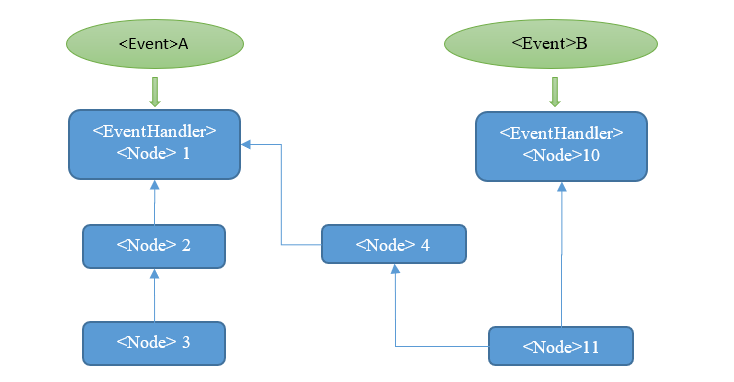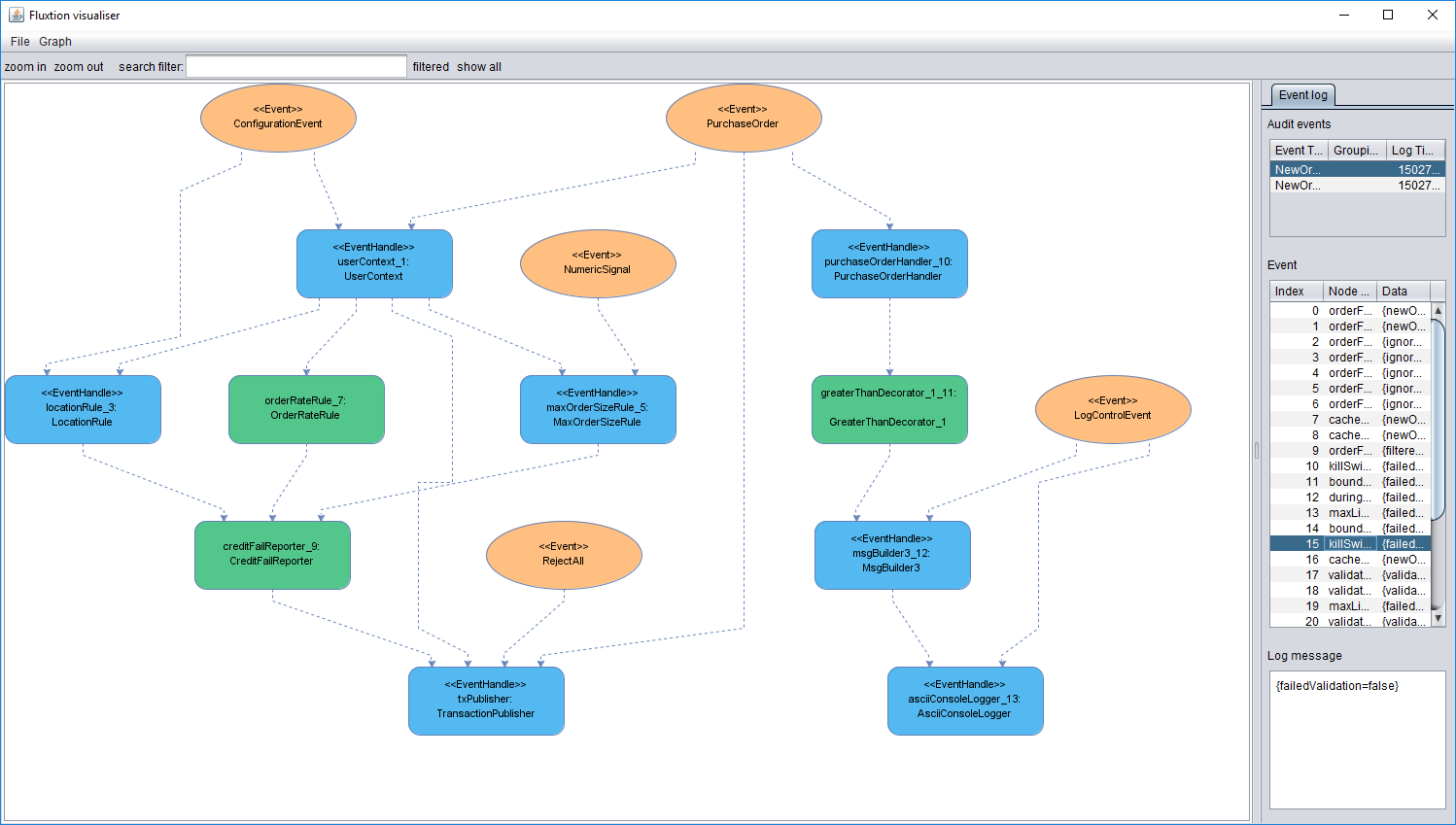Thanks for dropping by, hope we can persuade you to donate your time to investigate Fluxtion further.
Fluxtion is an embeddable streaming event processing engine written in Java. Describe the processing in a mixture of declarative and imperative forms and Fluxtion generates a decision engine. The engine is serialised as a set of java source files, that can be compiled and embedded in any java application. The application delivers events to the Fluxtion generated decision engine or Static Event Processor for stream processing. Engine generation can happen inline in the application or as part of the build process with a maven plugin.
Low latency, easy maintenance, zero gc, complex graph processing, simplified development and the "wow you can do that!!" reaction are the principles that guide our project.
As a stretch goal we would like to be the fastest single threaded java stream processor on the planet.
Fluxtion is focused on optimising the implementation of stream processing logic. Other stream processors support marshalling, distributed processing, event distribution, gui's and a multitude of other features. Fluxtion presumes there is an event queue that will feed it, and concentrates solely on delivering correct and optimal execution of application logic.
Want to upgrade your application logic without rewriting your infrastructure? Fluxtion is the perfect solution for you.
Check out detailed documentation at gitbook
Event processing support
-
- Batching or Streaming
- Lifecycle – init, terminate, after event
- Push and pull model
- Configurable conditional branching
- Handles complex graphs of thousands of nodes.
- Event filtering
- Event type
- Event type and static annotation value
- Event type and instance variable value
- Parent change identification
- Simple Integration of user functions
- Stateful or stateless
High performance
-
- Process hundreds of millions of events per second per core
- Optimal pre-calculated execution path generation.
- Zero gc
- Cache optimised
- JIT friendly code
- Type inference, no auto-boxing primitive access.
Developer Friendly
-
- Processing inference, no error prone separate graph description required.
- Easy to use annotation based api for build-time.
- Multi-language targets from one model, eg C++ processor from Java model.
- Seamlessly integrate declarative and imperative processing in one processor.
- Supports dependency injection.
Auditing
-
- Auditors record event and node execution paths for post processing analysis.
- graphml and png are generated as well as code.
- Audit records are in a structured machine friendly form.
- Graphml and audit records loaded into the visualiser for analysis.
- Dynamic property tracing using reflection.
- Auditors can record performance and profile systems or individual nodes.
Plugins
-
- Text processing
- Csv processing
- Complex event processing joins, group by, aggregates, windows
- Statistical functions
- State machine
- Functional support
Deployment
-
- Designed to be embedded
- Use within any java process from j2me to servers.
Multiple model definitions
-
- Imperative
- Declarative
- Dependency injection via annotation
- Data driven configuration via yml, xml or spring.xml
- Bespoke strategies
Source code as an asset
-
- Variable naming strategy for human readable code
- Audit friendly, prevents runtime dynamism.
- Simplifies problem resolution, no hidden libraries.
- Explicit generated code combats concryption – encryption by configuration.
Dynamic programming
-
- Generated parsers
- Optimised functions generated conditioned upon variants.
Generative programming
-
- Function generation
- Type inference, no autoboxing for primitives.
- Handler generation from processing inference.
- Core template customisation.
- Zero gc logger statically generated.
Tool support
-
- Maven plugin
- GraphML xml output
- Visualiser/analyser
See the quickstart example that demonstrates building a unix-like wc in java that processed 750 million events per second. The process is:
- Add Fluxtion libs and Fluxtion maven plugin to build file
- Code events and processors
- Execute build, Fluxtion generates decision engine as a Java source file
- Integrate engine into your app like any java class, and feed events
In a stream processor events are received and processed with predictable results. A set of dependent behaviours can be modelled as a directed acyclic graph. Each behaviour is a node on the graph and in our case these behaviours are functions. For predictable processing to hold true we can say the following:
- The first node on an execution path is an event handler.
- An execution path is formed of nodes that have the first event handler as a parent.
- Functions are nodes on the execution path.
- An event handler is a node that accepts an incoming event for processing.
- Functions will always be invoked in execution path order.
- Execution path order is topologically sorted such that all parent nodes are invoked before child nodes.
- A child node will be given a valid reference to each parent dependency before any event processing occurs.
For the example above:
- Event graph: Node 1, Node 2, Node 3, Node 4, Node 10, Node 11
- Event handlers: Node 1, Node 10
- Execution Paths:
- Event A: Node 1, Node 2, Node 3 Node 4, Node 11
- Event B: Node 10, Node 11
Fluxtion is unique among stream processors as there is no need for a Fluxtion server at runtime. Our code generated solutions remove the unnecessary cost, complication and inefficiencies required to integrate a streaming server into your application.
In general we try promote zero cost abstractions in Java, other langugages suchs as C++ and Rust this is a fundamental route to high performance, until now this has been missing in Java stream processing applications.
We believe generating code, png's, graphML and auditor injection points really reduce the most expensive element of any system, maintenance.
Please check out our vision for more discussion about where we see Fluxtion's place in the world.
The visualiser tool can load any graphml file created by Fluxtion for inspection.
We welcome contributions to the project. Detailed information on our ways of working will be written in time. In brief our goals are:
- Sign the Fluxtion Contributor Licence Agreement.
- Author a change with suitabke test case and documentation.
- Push your changes to a fork.
- Submit a pull request.
Fluxtion is licensed under the Server Side Public License. This license is created by MongoDb, for further info see FAQ and comparison with AGPL v3.0.
This README is a work in progress and will be updating regularly



